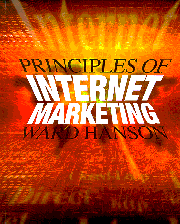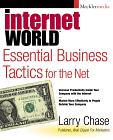|
|
| . |
|
|
|
|
| . |
|
|
| Jan
23 |
New Product Development Process |
New Product Development
Five steps in the New Product
Development Process,
|
| Jan
23 |
Chapter
8
New Product Development and the Net  |
New Product Development
- physical products - cyber products Internet Time Two important apsects, says Prof. Ward Hanson First - it refers to the rapid change and evolution of
|
| Jan
23 |
Chapter
8
New Product Development and the Net |
Standards and Conventions
(text p. 236)
Standards are specific limitations or physical features within which developers have to fit Conventions are general practices based on past history and common assumptions and expectations |
| Jan
23 |
Customization
Customization
Customization |
"Electronic Commerce allows for new products to be created and/or existing products to be customized in innovative ways. Such changes may redefine organizations' missions and the manner in which they operate." Building customer profiles,
with advanced techniques, allows for mass customization which will help
increase cross-selling, up-selling and CLV
In Judson's book (Page 126-127) he discusses Customization Judson explains that Product Customization is possible because of a convergence of two elements:
Call Bay - let's women design
and buy their own swim suits online
Continuing to develop this capability will be, says Judson, a combination of
|
| Jan
23 |
Customization Customization |
|
| Jan
23 |
Customization Customization |
www.abcnews.go.com/sections/business/TheStreet/customization_000616.html By Catherine Valenti "Many retailers are trying to stand apart from the competition by selling customized products and offering personalized services on the Web, and thereís no end to the quirky ideas that companies are using to give customers that personalized touch. Even though the cost of making customized goods often surpasses mass-producing items, companies say the customer loyalty they earn is worth it." Some products lend themselves
well to customization online.
"One example of e-tailers
moving to customization is Reflect.com,
a customized beauty site formed last September by Procter & Gamble
and Institutional Venture Partners. The firm makes everything from
lipstick to moisturizer based on a personís profile. Clients fill out an
online questionnaire that asks them everything from skin type to hair color.
Then they get to peruse a variety of products specially formulated for
them."
|
| . | Competitor
Intelligence 
Chapter 4 |
Larry Chase jokingly titles
this chapter http://007
subtitle is "Spying on Your Competitors and Yourself" beginning on p. 92, List of things you should look for on a competitor's web site
|
| . | Competitor
Intelligence |
Competitor Intelligence
who is a competitor
Business competitors are:
http://dialspace.dial.pipex.com/aware/competitor-analysis.shtml#Convert "... the relevance and importance
of each piece of information needs to be interpreted
some web sites devoted to
CI
|
| . | Competitor
Intelligence Historical
|
|
| . | Competitor
Intelligence Strategy
Historical
|
|